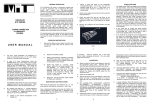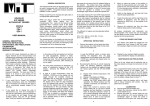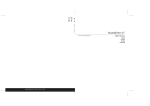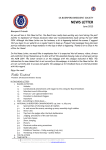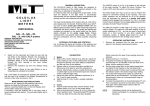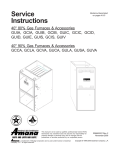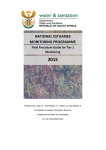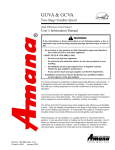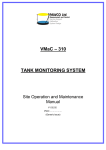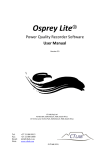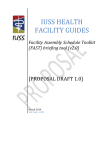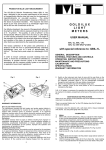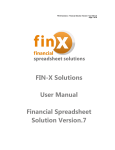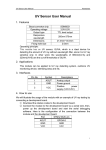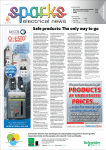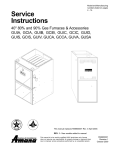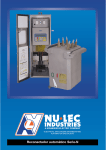Download GOLDILUX ULTRAVIOLET METERS USER MANUAL
Transcript
GENERAL DESCRIPTION GOLDILUX ULTRAVIOLET METERS USER MANUAL GUVA-1L/1H, GUVB-1L/1H/GUVC-1L/1H GUV-0L with all GUVAP, GUVBP and GUVCP probes GENERAL DESCRIPTION EXTERNAL FEATURES AND CONTROLS OPERATING INSTRUCTIONS MAINTENANCE AND PRECAUTIONS CALIBRATION SPECIFICATIONS OPERATING INSTRUCTIONS 1. 2. 3. 4. Take the instrument from its storage place and plug in the external probe (if used), mounting or placing it in the position where measurements are to be made. Switch on the instrument and check its zero with the cap firmly on the detector (of either the meter or the probe, depending on which is being used for the measurement). For a meter or probe zero adjustment, see the applicable paragraphs of the calibration section. A zero adjustment may be performed at any time without affecting the calibration status of the instrument. Remove the protective cap from the detector being used. Take readings. If the probe range selector switch is at a setting other than x1, the reading must be multiplied by the selected range factor. MAINTENANCE AND PRECAUTIONS Avoid touching the detector (H in Fig. 1 or D in Fig. 2) as natural oils and acids from the skin may form a layer, which absorbs UV, or could etch and damage the surface. The detector can be cleaned with a soft clean cloth or tissue moistened with alcohol. Dry and polish lightly with a dry tissue. 4 If the UV-A and UV-B meters have to be used for the measurement of wide-band UV sources (which emit UV radiation over a wide range of wavelenghts, like for instance sunlight), this should only be done after having the meters re-calibrated for that specific type of wide-band source. UV-C meters should not be used for measurements on wide-band sources like sunlight at all, quite apart from the fact that there is no UV-C component in sunlight. The different UV regions are internationally defined as follows:UV-A: 315 - 400 nm, UV-B: 280 - 315 nm, UV-C: 100 - 280 nm. A wide range of meters and probes, covering the various UV regions as well as different measuring ranges and application areas are available. Ask your authorised GOLDILUX dealer for an up-to-date product chart if you need to select the best meter for your requirements. Any external UV probe (e.g. UV-B) can be plugged into any model of UV meter (e.g. UV-A). In this case the UV detector in the meter is automatically disconnected and the displayed reading corresponds to the quantity measured by the probe (units as stated on the probe). External probes cover an even wider measuring range than the meters with a built-in detector as they have a built-in range selector switch (A in Fig. 2) to toggle between two range factors. On a setting other than unity, the reading has to be multiplied by the indicated range factor. Probes combined with a non-specific meter are thus an economic alternative to meters with built-in detectors in cases where the widest possible range is required. 1 2 3 When not in use, always put the protective cap on the detector and keep the instrument in a safe place. There is a warning "battery low" on the LCD display when the 9V battery needs to be replaced. b) With the cap firmly on the probe detector (D in Fig. 2) adjust the meter reading to zero via potentiometer P5 as indicated on the probe's rear panel label. For high-gain probes (probes with a range factor <.1) this may only be possible to within ± 5 in the least significant digit. c) Expose the probe to a known power per unit area, emitted by a UV source radiating in the wavelength region to which the probe is sensitive and of the type with which the probe is going to be used. Alternatively, make a comparison reading with a UV meter calibrated for the appropriate UV spectral region. d) Adjust the meter reading with the probe calibration adjustment (P1 as indicated on the probe's rear panel label), until the meter reading is correct. e) Set the range factor selector switch to the highest range factor and adjust P2 (as marked on the probe's rear panel label) until the reading is exactly 10 times lower than with the range factor switch in the lowest setting. f) Once the rear panel label is pierced to make a calibration adjustment, it should be sealed again with a suitable calibration sticker. NOTE: Calibrations should only be performed by trained metrologists in a recognized calibration laboratory. Additional information on the meter for the qualified meteorologist: a) Open the meter housing and adjust the voltage between TP1 and TP2 to 7.50 ± 0.02 V via potentiometer R2. (Note: Two of the housing screws are covered by the rear panel label, the other two are accessible through the open battery compartment). b) Adjust the voltage between TP3 and TP4 to 1.000 ± .001 mV via potentiometer R26. Close the meter housing. The GOLDILUX series of ultraviolet meters consists of a number of different models of UV-A, UV-B and UV-C meters (with built-in detector and display, Fig. 1) and a series of external probes (with built-in detector, but without display, Fig. 2). The external probes can either be used in combination with any of these meters or together with a non-specific UV meter (without built-in detector, but with display). The non-specific UV (GUV0L) meter can only be used in conjunction with an external probe and not by itself. The instruments measure the power per unit area of the UV radiation falling on the detector. The external probes can also be ordered with a dose option (discontinued as from 1 Jan 2000), in which case they can also be used to measure the UV energy per unit area falling on the detector over a certain period. Please contact the manufacturer (MIT) for re-calibration of these units. Such measurements of UV-energy can now be performed far more efficiently by the “Smart Meter” series of instruments. The meters and probes have been specifically designed and calibrated for use with narrow-band UV sources (most UV lamps). In such UV sources most of the UV radiation is emitted in a narrow wavelength region around a dominant spectral line. CALIBRATION 1. a) b) c) d) 2. a) Meters For meters with built-in detector: With no probe plugged in and the cap firmly on the detector, adjust the meter reading to zero via the potentiometer accessible through the opening in the open battery compartment. Expose the meter to a known power per unit area, emitted by a UV source radiating in the wavelength region to which the meter is sensitive and of the type with which the UV meter is going to be used. Alternatively, make a comparison reading with meter calibrated for the appropriate spectral region. Adjust the meter with the calibration adjustment (F in Fig. 1) until it reads correctly. Seal the hole (F in Fig. 1) with a suitable calibration sticker. Probes Plug the probe into the meter and set the probe's range factor selector switch (A in Fig. 2) to the lowest range factor. 5 6 EXTERNAL FEATURES AND CONTROLS Fig. 1 indicates the location and function of the various switches, connectors and other features of the UV meters, which are accessible externally. The same features for the external UV probes are shown in Fig. 2. The meter ON/OFF switch (A in Fig. 1) is located on the side of the meter housing and should be moved forward to switch on the meter. The hold button (B in Fig. 1) can be used to "freeze" the display for convenient reading by the operator. The operation of this hold button can also be effected by using a remote hold cable plugged into the remote hold connector (C in Fig. 1). The meters also provide an analog output (stereo socket D in Fig. 1), which supplies a 2V output for a full-scale reading. It has an output impedance of 10 k and can be used to record UV levels on a chart recorder or any other suitable data acquisition system. SPECIFICATIONS Measurement parameter: Irradiance (power per unit area) or energy density (dose). Dynamic range: Meters: 1:200 000, Probes: 1 : 2 000 000. Readout : 4½ digit LCD display with autoranging over one decade Power source : 9V type PP3 battery. Battery life approximately 200 hours for alkaline battery (without using an external probe). Detector : UV-enhanced silicon photodiode with filtering for either UV-A, UV-B or UV-C. 7 Spectral response : As indicated in Fig. 4 (nominal values). Accuracy : Factory setting 5% (UV-A), 10% (UV-B), 15% UV-C. These figures are applicable for line sources centred at 365 nm (UV-A), 313 nm (UV-B) and 254 nm (UV-C). Otherwise, as stated on the calibration certificate by a recognized calibration laboratory. Angular response : As indicated in Fig. 3 (nominal values). Dimensions : Meters : 150 x 80 x 37 mm, Probes : 110 x 60 x 30 mm. Mass : Meters : 230 g (with battery), Probes : 120 g (with cable). Accessories : Protective cap for detector, manual. Re-calibration : Return unit to a recognized calibration laboratory for recalibration every 6-12 months (depending on total dose exposed to) or if calibration is in doubt for any reason. 8 replacement product to the approved distributor, who shall be responsible for the shipping charges to the customer. Warranty limitations The manufacturer makes no other warranty, either expressed or implied, with respect to these products. The manufacturer specifically disclaims the implied warranties of merchantability and fitness for a particular purpose. Some states or provinces do not allow limitations on the duration of an implied warranty, therefore the above limitations or exclusion may not apply to you. However, an implied warranty of merchantability or fitness is limited to the one (1) year duration of this written warranty. This warranty gives you specific legal rights, and you may also have other rights which may vary from state to state, or province to province. Exclusive remedies The remedies provided herein are the customer's sole and exclusive remedies. In no event shall the manufacturer be liable for any direct, indirect, special, incidental or consequential damages, whether based on contract, tort, or any other legal theory. Some states or provinces do not allow the exclusion or limitations of incidental or consequential damages, thus the above limitation or exclusion may not apply to you. 12 Warranty Information Fig. 1 Fig. 3 Fig. 2 Fig. 4 9 Approved distributor’s address BEKA (Pty) Ltd PO Box 120, Olifantsfontein, 1665 Tel: (011)238-0000 Fax: (011) 238-0180 Attn: Murray Cronje, Gustav Kritzinger/Adam E-Mail: [email protected] Http://www.beka.co.za CEATEC PO Box 211, Umzumbe, 4225 Tel: (039) 699-2293 Fax: (039) 699-3129 Attn: Chris Early E-Mail: [email protected] Http://www.ceatek.co.za CT LABS PO Box 897, Stellenbosch, 7599 Tel: (021) 880-9915 Fax: (021) 880-1863 Attn: Hendrik Burger E-Mail: [email protected] Http://www.ctlab.com ENVIROCON INSTRUMENTATION C.C. PO Box 2686, Northcliff, 2115, JHB Tel: (011) 476-7323 Fax: (011) 476-5995 Attn: Howard Palmer, Dion van Riet, Brian Stowe E-Mail: [email protected] Http://www.envirocon.co.za 13 10 One (1) year limited warranty The manufacturer warrants the light meters and probes against defects in materials and workmanship for a period of one (1) year from the date of original retail purchase (proof of purchase required). If an approved distributor receives notice of such defects during the warranty period, he will either, at its option, repair or replace products which prove to be defective and receive a replacement from the manufacturer. Exclusions: The above warranty shall not apply to defects resulting from improper or inadequate maintenance by the customer, customer-supplied software or interfacing, unauthorized modifications or misuse, operation outside the environmental specifications for the product, improper site operation and maintenance, an accident or abuse. Obtaining warranty service: To obtain warranty service, the products must be returned by the purchaser to an approved distributor. Repair or replacement of the instrument will be at the discretion of the technician at the manufacturers. They have to be notified of the warranty claim and the defective product returned to them. Replacement will be at no charge if deemed to be necessary. Shipping charges from the customer to an approved distributor shall be to the account of the customer and shipping charges from the approved distributor to the manufacturer shall be paid by the approved distributor. The manufacturer shall pay for the return of the 11 GfG (Pty) Ltd PO Box 2673, Randburg, 2125 Tel: (011) 955-4862 Fax: (011) 955-4741 Attn: Griselda, Casper van der Westhuizen E-Mail: [email protected] Http://www.gfg.co.za MAGNITEC PO Box 27129, Benrose, 2011 Tel: (011) 618-2720/9 Fax: (011) 614-9603 Attn: Paul Nicolai E-Mail: [email protected] Http://www.magnitec.co.za GAMMATEC ENGINEERING (Pty) Ltd PO Box 264786, Vereeniging, 1939 (016) 454-0260 Fax: (016) 423-3442 Attn: Quinton Bouwer, Nic Coetzer, Jenny E-Mail: [email protected] Opaque Reference Equipment PO Box 25163, Edelweiss, 1577 3 Fulmar Rd, Daggafontein, Springs, 1559 T: (011) 363658 F: (011) 818 5870 E-mail- [email protected] AMS HADEN Suite 247 Pvt Bag X09, Weltevreden Park, 1714 Attn: Tony Gripping / Steve Bishop T: (011) 475-2064 F: (011) 475-2062 E-Mail: [email protected] H. Rohloff (Pty) Ltd 770 4th street, Wynberbg, Sandton, 2 PO Box 202, Bergvlei, 2012 Tel: (011) 786-3020 Fax: (011) 887-7199 E-mail: [email protected] NDIGENOUS SYSTEMS PO Box 2662, Halfway House, 1685 Tel: (011) 315-6444 Fax: (011) 315-6432 Attn: Charles Philips, Fanie E-Mail: [email protected] 14 THE DEVENPORT RD LIGHTING COMPANY 73 Buitengracht Str, Tamboerskloof, CapeTown, 8001 Tel: (021) 424-7687 Fax: (021) 424-5211 Cell: 082 4900 350 Attn: Greg Segal E-Mail: [email protected] Http://www.devlight.co.za 15


